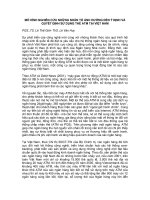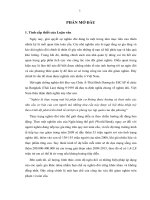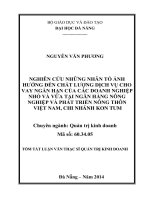Nghiên cứu những nhân tố ảnh hưởng việc học phát âm Tiếng Anh của học sinh người H’Mông trường THPT Hàm Yên, huyện Hàm Yên, tỉnh Tuyên Quang
Bạn đang xem bản rút gọn của tài liệu. Xem và tải ngay bản đầy đủ của tài liệu tại đây (593.51 KB, 55 trang )
VIETNAM NATIONAL UNIVERSITY, HANOI
UNIVERSITY OF LANGUAGES AND INTERNATIONAL STUDIES
FACULTY OF POST-GRADUATE STUDIES
*********************
ĐỖ THỊ THU HẰNG
A STUDY ON FACTORS AFFECTING ENGLISH PRONUNCIATION
LEARNING OF HMONG STUDENTS AT HAM YEN HIGH SCHOOL,
HAM YEN DISTRICT, TUYEN QUANG PROVINCE
Nghiên cứu những nhân tố ảnh hưởng đến việc học phát âm Tiếng Anh của
học sinh người H’Mông trường THPT Hàm Yên,
huyện Hàm Yên, tỉnh Tuyên Quang
M.A MINOR PROGRAMME THESIS
FIELD: ENGLISH TEACHING METHODOLOGY
CODE: 60140111
Hanoi, 2014
VIETNAM NATIONAL UNIVERSITY, HANOI
UNIVERSITY OF LANGUAGES AND INTERNATIONAL STUDIES
FACULTY OF POST-GRADUATE STUDIES
*********************
ĐỖ THỊ THU HẰNG
A STUDY ON FACTORS AFFECTING ENGLISH PRONUNCIATION
LEARNING OF HMONG STUDENTS AT HAM YEN HIGH SCHOOL,
HAM YEN DISTRICT, TUYEN QUANG PROVINCE
Nghiên cứu những nhân tố ảnh hưởng đến việc học phát âm Tiếng Anh của
học sinh người H’Mông trường THPT Hàm Yên,
huyện Hàm Yên, tỉnh Tuyên Quang
M.A MINOR PROGRAMME THESIS
FIELD: ENGLISH TEACHING METHODOLOGY
CODE: 60140111
SUPERVISOR: Dr. TRAN THI THU HIEN
Hanoi, 2014
i
DECLARATION
I hereby certify that the thesis entitled “A study on factors affecting
English pronunciation learning of ethnic students in Ham Yen High School,
Ham Yen District, Tuyen Quang province” is my own study in the fulfillment
of the requirement for the Degree of Master of Arts at the Faculty of Post
Graduate Studies, University of Languages and International Studies,
Vietnam National University, Hanoi.
Signature
Đỗ Thị Thu Hằng
ii
ACKNOWLEDGEMENTS
*****
I would like to express my gratitude to all who have helped me in the
completion of this thesis.
Firstly, I am deeply indebted to my supervisor, Dr. Tran Thi Thu Hien,
who has given me persistent consideration, enthusiastic encouragement,
and invaluable supervision throughout the writing of the thesis.
Secondly, my thanks also go to all lecturers and the staff of Faculty of
Post Graduate Studies, University of Languages and International Studies,
Vietnam National University, Hanoi for their useful lectures, materials,
guidance and enthusiasm during my course.
Thirdly, I also thank my colleagues for their willingness to share their
ideas on this study and my students for their cooperation in completing the
survey questionnaires.
Last but not least, I am indebted to my family and all my friends who
have kindly given me assistance and encouragement. Without them, this
study would have no such great motivation.
iii
ABSTRACT
Ham Yen High School is a mountainous school where most of students
are ethnic. They account for 63 percent of all students in the school, in which
Hmong students cover 83 percent. Most of them have difficulty in English
pronunciation learning. Until now, no research on English pronunciation
learning of the ethnic learners at Ham Yen High School has been carried out.
The researcher, therefore, decides to convey the research with the aim
of finding out factors affecting Hmong students’ pronunciation learning,
investigating typical pronunciation errors that Hmong students often commit,
and proposing possible suggestions. To achieve the objectives of the current
study the researcher use both qualitative and quantitative methods. The data
were obtained from students’ survey questionnaires, students’ test result, and
teachers’ interview. The data were then analyzed. From the result, it can be
concluded that the first language transfer, language exposure, and attitudes
and motivation are among the most significant factors affecting Hmong
students’ pronunciation learning.
It is hoped that this thesis will be useful for teachers at Ham Yen High
School to improve Hmong students’ pronunciation.
iv
LIST OF ABBREVIATIONS
EFL: English as a Foreign Language
ESL: English as a Second Language
L1: First language
L2: Second language
v
LIST OF TABLES AND CHARTS
Table 1: Hmong students' interest in learning English pronunciation
Table 2: The purpose of teaching and learning pronunciation
Table 3: Students' evaluation on difficulty in learning English consonants
Table4: Students’ answers for the test
Table 5: Factors affecting pronunciation learning
Table 6: Frequency of techniques used in teaching pronunciation
Table 7: The favourite techniques of learning pronunciation
Chart 1: Students’ time on English pronunciation learning
Chart 2: The language students speak at home
vi
TABLE OF CONTENT
DECLARATION i
ACKNOWLEDGEMENTS ii
ABSTRACT iii
LIST OF ABBREVIATIONS iv
LIST OF TABLES AND CHARTS v
PART A: INTRODUCTION 1
1. Rationale of the study 1
2. Objectives of the study 1
3. Research questions 2
4. Scope of the study 2
5. Methods of the study 2
6. Significance of the study 3
7. Design of the study 3
PART B: DEVELOPMENT 5
CHAPTER 1: LITERATURE REVIEW 5
1.1. Perceptions of pronunciation 5
1.2. Features of pronunciation 6
1.3. Factors affecting English pronunciation learning 7
1.3.1. Age 7
1.3.2. First language transfer 7
1.3.3. Personality 8
1.3.4. Language exposure 8
1.3.5. Attitude and motivation to learn 9
1.4. Hmong phonology overview 9
1.4.1. Word structure 10
1.4.2. Consonants 10
1.4.3. Tones 11
vii
1.5. Chapter summary 11
CHAPTER 2: METHODOLOGY 12
2.1. Context of the study 12
2.2. The participants 12
2.3. Data collection instruments 13
2.3.1. The questionnaires: 13
2.3.2. Test 13
2.3.3. Interview 14
2.4. Data collection procedures 14
2.4.1. For the questionnaire 14
2.4.2. For the interview 14
2.4.3. For the test 15
2.5. Chapter summary 15
CHAPTER 3: DATA PRESENTATION AND DISCUSSIONS 16
3.1. Data analysis 16
3.1.1. The teachers’ and students’ attitudes towards teaching and
learning pronunciation 16
3.1.2. Students’ pronunciation errors 18
3.1.3. Factors affecting Hmong students in pronunciation learning 21
3.1.4. Techniques used in teaching pronunciation 24
3.1.5. Students’ expectations and teachers’ recommendations to teaching
and learning pronunciation. 26
3.2. Findings and discussion 28
3.3. Possible suggestions 28
3.3.1 Teachers’ techniques 29
3.3.2. Motivating students to learn 31
3.3.3. Equipping facilities 31
3.4. Chapter summary 32
viii
PART C: CONCLUSION 33
1. Major findings 33
2. Limitations of the study 35
3. Recommendations for further studies 35
REFERENCES 37
APPENDIX 1 I
APPENDIX 2 VI
APPENDIX 3 VII
1
PART A: INTRODUCTION
1. Rationale of the study
It cannot be denied that English is by far the most popular language of
all. Nowadays, English is popular enough to be spoken at every corner of the
world. Therefore, teaching and learning English have become the necessity in
every country. Since Vietnam began its open-door policy, the English
teaching and learning has strongly developed.
Pronunciation is an integral part of foreign language learning since it
directly affects learners' communicative competence as well as performance.
Limited pronunciation can decrease learners’ self-confidence and restrict
social interactions in learning. The current focus on communicative
approaches to EFL pronunciation learning and the concern for building
communication skills are renewing interest in the role that pronunciation
plays in EFL learners’ overall communicative competence.
Ham Yen High School is a mountainous school where most of students
are ethnic. They account for 63 percent of all students in the school, in which
Hmong students cover 83 percent. Most of them have difficulty in English
pronunciation learning. Until now, no research on English pronunciation
learning of the ethnic learners at Ham Yen High School has been carried out.
The researcher, therefore, decides to convey the research with the hope that
this study can help improve pronunciation learning of the students at the
school in particular and similar cases at other schools in Vietnam in general.
2. Objectives of the study
The inter-related aims of the study are:
- Investigating on typical pronunciation errors that Hmong students often
commit.
2
- Finding out factors affecting English pronunciation learning of Hmong
students at Ham Yen High School.
- Proposing suggestions to improve English pronunciation learning of
Hmong students at Ham Yen High School.
3. Research questions
In the thesis, the following questions will be answered.
i) What kinds of English pronunciation errors do Hmong students at Ham
Yen High School usually have?
ii) What are the major factors affecting English pronunciation of Hmong
students at Ham Yen High School?
iii) What should be done to improve English pronunciation of Hmong
students at Ham Yen High School?
4. Scope of the study
This study is concerned with finding factors that affect learning English
pronunciation of Hmong students at Ham Yen High School. All studies
focusing on factors that affect the learning of other knowledge of other
students at other schools are outside the scope of this study.
Data collected for this thesis are mainly from Hmong learners and some
teachers of English in this school.
5. Methods of the study
In order to fulfill the tasks mentioned above, both qualitative and
quantitative methods are selected for this study. The study adopts survey
research approach. A survey questionnaire is designed for 55 Hmong students
at Ham Yen High School, Tuyen Quang as the main instrument to find out the
factors affecting their English pronunciation learning. Using survey
questionnaire, the researcher is allowed to get answers from a lot of students
in a relatively short space of time. Moreover, questionnaires provide lots of
3
data for analysis, and the more data sets, the more accurate the analysis is.
However, there are some problems arising when using survey questionnaires
to collect data. First, the researcher use closed - ended questions, so it is
difficult to allow students to expand their answers. Second, survey
questionnaires are impersonal; students, therefore, may be more open face to
face discussions. Based on these reasons, interviews have been also conducted
to get supplementary information. Together with survey questionnaire and
interview, a test is designed with the aim of investigating on typical
pronunciation errors that ethnic students often commit.
6. Significance of the study
This study hopes to make contribution to teaching English
pronunciation for Hmong students at high school level in Vietnam and is
expected to be useful reference material for any high school language
teachers in Vietnam, especially for those who are in favor of improving their
Hmong students' pronunciation in particular and other ethnic minorities in
general.
7. Design of the study
The study is organized three parts as follows:
Part A-Introduction presents rationale, objectives, research questions,
scope, methods, significance, and design of the study.
Part B-Development is divided into three chapters.
Chapter 1 presents a review of literature and theoretical background
about English pronunciation learning, its perceptions and features. This
chapter is concentrated on the five factors affecting English pronunciation
learning. Then, the chapter ends with an overview of Hmong phonology.
Chapter 2 describes the context of the study, the participants, data
collection instruments as well as the data collection procedures.
4
Chapter 3 presents data analysis, findings and discussions, and possible
suggestions.
Part C-Conclusion provides conclusion, limitations and future research
of the study.
5
PART B: DEVELOPMENT
CHAPTER 1: LITERATURE REVIEW
This chapter provides the background information about pronunciation
and pronunciation learning. First, some of the background information
pertaining to pronunciation will be presented. Then, an overview of the
features of pronunciation and factors affecting English pronunciation learning
will be presented. Finally, this chapter will examine what is known about the
Hmong language, including its origin, word structure, consonants and tones.
1.1. Perceptions of pronunciation
The notion of pronunciation has been defined in many different ways
by writers. Generally speaking, pronunciation is simply defined as “the way in
which a word is spoken” (Oxford Advanced Learner’s Encyclopedic, 1992) or
“the way in which a word is usually pronounced” (Longman Dictionary of
Contemporary English, 1978). Christiane Dalton and Barbara Seidlhofer
(1994:3) consider pronunciation “as the production of significant sound”.
They look at word in two senses. First, it is used as part of a code of a
particular language. That is the reason why English sounds are distinguished
from sounds of other languages. In this sense, pronunciation can be told as the
production and reception of sounds of speech. Second, sound is used to
achieve meaning in contexts of use. Here the code combines with other
factors to make communication possible. In this sense pronunciation is
referred with reference to acts of speaking.
In this study, the concept of pronunciation can be described as “a way
of speaking a word, especially a way that is accepted or generally
understood” (American Heritage Dictionary, 1992) or “may be said to
conclude the sounds of the language or phonology; stress and rhythm;
intonation; combination sounds; linkage of sound” (Ur, 1996).
6
1.2. Features of pronunciation
Pronunciation features are typically grouped in two categories:
segmentals and suprasegmentals. Segmental features are the sound inventory
of a language. Standard English has twenty vowels and twenty-four consonant
sounds, for a total of forty distinct sounds that enable speakers to distinguish
one word from another (Florez, 1998). Suprasegmentals, in contrast, encode
rich information structure, giving the listener the ability to detect emphasized
words, speech acts (e.g. statements vs. questions), phrasal boundaries,
attitudes and emotions. This suprasegmental information presents itself in the
following sounds features:
stress – the length, volume, and pitch applied to syllables in words and
sentences
rhythm – the beat pattern of stressed and unstressed syllables (tied with
sentence stress)
adjustments in connected speech – changes in sounds when words blend
together in speech
prominence – vocally highlighting words in speech to express meaning,
new vs. old information, or intent, by use of loudness, length, pitch and
vowel quality
intonation – the rise and fall of voice pitch in sentences and phrases
According to Meng et al. (2009), while perceptual studies indicate that
both segmental and suprasegmental features impact expert judgments on
speaking proficiency, suprasegmentals have a greater effect for the overall
comprehension of the message. Meng (2009:1) states, “suprasegmental
features encode rich information structure that helps the listener locate
emphasized words, phrase boundaries, speech acts (e.g. statements,
questions, continuations, etc.) as well as the speaker’s attitudes and
7
emotions”. In Derwing and Rossiter (2002) survey of 100 ESL students, the
participants perceived segmental issues to be the crux of their pronunciation
difficulties despite the fact that these features have a low functional load. The
participants’ awareness of suprasegmental features was limited. Therefore,
negative transfer of suprasegmental features can disrupt clear
comprehensibility of the intended message, and the detrimental effects would
naturally be greater when the L1 is more markedly different than the L2.
1.3. Factors affecting English pronunciation learning
1.3.1. Age
The first, rather controversial, factor is age. The debate over whether
there is a critical period for language learning has been an arduous one. Celce-
Murcia et al. (1996) and Florez (1998) examine the debate over the impact of
age on pronunciation. Some researchers insist that after a learner goes through
puberty, lateralization of the brain occurs. Lateralization, or the assigning of
linguistic functions to specific brain hemispheres, results in learners‟
difficulty in acquiring and being able to produce new sounds to the extent
possible by a child. Other researchers argue that various sensitive periods for
language learning exist and that “adults need to re-adjust existing neural
networks to accommodate new sounds” (Florez, 1998). However, in general,
research has shown that adults have more difficulty with pronunciation than
children when learning a new language.
1.3.2. First language transfer
A learner’s first language (L1) can have significant influence on the
level of accentedness and intelligibility of the new language. Negative
transfer, also called interference, means that the features of the L1 are carried
into the second language (L2). With differences between the two languages,
negative transfer can lead to erroneous production of aspiration, rhythm, and
8
intonation in the new language (Florez, 1998). According to Meng et al.
(2009), language transfer occurs at both the segmental and suprasegmental
levels, and these interference effects can become fossilized with age, creating
challenges for adult L2 learners. It is showed in some studies that the more
differences that the native and target language have, the more difficult
pronunciation of target language will be.
1.3.3. Personality
Non-linguistic factors related to an individual’s personality and
learning goals, attitude towards the target language, culture, native speakers,
and type of motivation which are beyond the teacher’s control (Miller, 2003)
all have their share in the development of pronunciation skills. In addition, the
degree of exposure to and use of the target language can support or impede
pronunciation skills development. For example, learners who are outgoing
and confident and get involved in interactions with native speakers are liable
to practice their foreign language pronunciation (Avery & Ehrlich, 1992).
Conversely, some learners feel uncomfortable trying out new speech rhythm
and melody patterns (Miller, 2003), while others feel stupid pronouncing
“weird” sounds, and with time, they decide that it is futile and impossible to
learn English pronunciation (Laroy, 1995). In this respect, Miller (2003)
believes that changing – and not changing – speech patterns is affected by
how much responsibility the student takes, how much the student practices
outside of class, and how ready the student is.
1.3.4. Language exposure
The length of time a person has spent interacting with the language
could have an impact, and, perhaps more importantly, the quantity and quality
of English interaction in day-to-day activities can be critical 15 (Singer,
2006). Languages are acquired by receiving large amounts of comprehensible
9
input. This comprehensible input can be easily seen when visiting a quality
elementary school where students interact freely in a comfortable setting.
Adults, on the other hand, often spend their days working in an environment
without a rich source of comprehensible input. Socializing often occurs with
people from their linguistic group. In Singer’s (2006), the most definite factor
determining accurate pronunciation was the learners’ daily exposure to
English.
1.3.5. Attitude and motivation to learn
While a number of students might take English in school to reach their
score and future professional goals, others might be feeling forced to learn
English. In addition, some might feel conflicted about learning a new
language if they feel it will result in the eventual loss of their L1. The
development of pronunciation intelligibility can be positively or negatively
influenced by one’s attitude toward the new culture, its language and
speakers. Concurrently, personal identity issues and motivation for learning
also can support or impede pronunciation (Florez, 1998). Elliott (1995)
showed that a student’s motivation toward achieving the target language’s
pronunciation was the principal variable in their accuracy of actual
pronunciation output.
We still found that the students’ motivation is of vital importance in his
or her pronunciation learning. And sometimes, some students speak English
when they receive others’ praise for their beautiful English, which might give
them a strong sense of achievement.
1.4. Hmong phonology overview
In Chang’s (2005), the basic phonological unit in Hmong is the
syllable, not the word. Most morphemes are monosyllabic, and most syllables
have transparent meanings. Words, if polymorphemic, are analytic, and for
10
this reason, they are sometimes called “terms”, with the morphemes
themselves being called “words”. Each Hmong syllable has an onset, a rime,
and a tone, out of a total possible of 57 onsets, 13 rimes, and 7 tones. What
complexity there is in the onset is made up for in the simplicity of syllable
codas, for the rimes are all zero-coda, except for two that end in [ŋ]. In a
language such as Hmong, it is more convenient to speak of onsets and rimes
than of segments. Whereas it is quite right to say that an onset such as [mpl],
which represents a pre-nasalized bilabial stop with an overlapping lateral, is 3
distinct segments, the fact that such clusters are relatively few compared to
the number of segments in the language persuades me to structure my analysis
around onsets and rimes rather than around segments.
1.4.1. Word structure
Most Hmong-Mien words are monosyllabic (Chang, 2005). They start
with one or more consonants followed by a vowel and, sometimes, by a final
consonant.
1.4.2. Consonants
In Chang’s (2005), Hmongic languages have a large number of initial
consonants, including retroflex, uvular and glottal sounds, besides the usual
labial, dental/alveolar, palatal and velar. Voiceless stops and affricates are
more common than voiced ones. Stops and affricates can be aspirated or pre-
nasalized, yielding a 4-way contrast: voiceless unaspirated, voiceless
aspirated, voiceless prenasalized, and voiced. Those languages that do not
have voiced stops (like Hmong) may pronounce a voiceless stop with both
prenasalization and aspiration yielding a slightly different 4-way contrast in
which all stops are voiceless: unaspirated, unaspirated prenasalized, aspirated,
aspirated prenasalized.
11
Another interesting feature of Hmongic consonant systems is the
occurrence of contrasting pairs of voiceless and voiced nasals (voiceless
nasals are comparatively rare in world languages). The only permitted final
consonants are the dental and velar nasals (n, ŋ). In contrast, the inventory of
Mien initial consonants is smaller but more consonants are permitted in final
position, including three nasals (m, n, ŋ) and three stops (p, t and glottal ʔ).
1.4.3. Tones
All Hmong-Mien languages are tonal (Chang, 2005). Many have an
exceptionally large number of tonal contrasts that can reach up to eleven or
twelve. They serve to make lexical distinctions. As well as pitch contrasts,
Hmong-Mien tones may have different voice qualities like 'breathy' or
'creaky'.
1.5. Chapter summary
To summarize, in this chapter, some theoretical backgrounds relating to
teaching and learning pronunciation have been pointed out. These are the
pronunciation concepts and their features. Factors relating to pronunciation
teaching and learning have been also given. It cannot be denied that
pronunciation and teaching pronunciation is an important part to conduct in
any language course.
12
CHAPTER 2: METHODOLOGY
2.1. Context of the study
Located in northern of Tuyen Quang, Ham Yen is a mountainous
district with three upper secondary schools, in which Ham Yen High School
is the leading choice of parents and students when they finish lower secondary
schools. The school has 34 classes and 87 teachers, and 6 classrooms
equipped with projectors and LCD screens. Ham Yen High School was also
equipped with a lab for foreign language learning two years ago.
However, teaching and learning English at Ham Yen High School have
some difficulties. Most of the classes are rather big, about 40 or more than 40
students in a class. In addition, students hardly have opportunities to
communicate with native speakers.
There are 8 teachers of English at Ham Yen High School. All of them
are from 30 to 40 years old, in which six graduated from in-service training
programs, and the other two finished their tertiary education in Foreign
Language Department in Thai Nguyen University of Education. All the
teachers are very enthusiastic with teaching and want to improve the quality
of English teaching and learning.
1287 students are studying at Ham Yen Upper Secondary School. Most
of them have been learning English since they were at grade 3. Despite the
fact that they have at least 7 years to study English as a compulsory subject,
most of them find learning and pronouncing English difficult. As a result, two
thirds of them often get mark below 6 for their forty-five minute tests.
2.2. The participants
Data of the study are collected from 5 teachers of English and 55
students at Ham Yen High School. All of the five teachers are female and age
from 30 to 40. They have been teaching English for at least 6 years, so it can
13
be said that all of them are experienced in teaching English. They graduated
from both regular and in-service training programs.
55 students chosen are Hmong learners, as students from other ethnic
minority groups are too few to be considered. The fifty-five male and female
students have been chosen randomly in which 15 students are form grade 10,
17 students are from grade 1, and the rest are from grade 12.
2.3. Data collection instruments
As mentioned in the above section, to collect information and data, three
instruments: questionnaire, interview and test were used.
2.3.1. The questionnaires:
A survey questionnaire with closed questions was administered to
collect data from 55 Hmong students at the twenty-fifth week of the second
term.
The questionnaire consists of 13 questions which are designed in
three parts with aiming at answering the three research questions mentioned
above. To get this aim, the questionnaire is categorized into the following
groups:
Personal information
Information about English pronunciation learning
Information about English pronunciation teaching
Students’ expectation of English pronunciation learning
In order to collect reliable data and information from the subjects,
questionnaires for students were designed in Vietnamese and the students
were given 25 minutes to finish their answers.
2.3.2. Test
Based on the interviews of 5 teachers and the researcher’s personal
experience and observation of pronunciation lessons, only sounds that ethnic
14
students often pronounce wrong are tested. The test of 26 questions is
designed for 55 students with the aim of ensuring typical pronunciation errors
that students often commit. There are three exercises. The first one is an odd-
one-out exercise. The next is the exercise of writing the words basing on the
given transcriptions. In exercise 3, students have to give the phonetic
transcriptions of the common words which they have learnt in their English
programs at Ham Yen High School.
2.3.3. Interview
The interview with five teachers at Ham Yen High School was
conducted: one graduated from a regular university, and others graduated
from in-service training programs. There are seven questions proposed to get
the teachers’ ideas of pronunciation teaching and learning reality, factors
affecting their students’ learning of English pronunciation and some
recommendations to improve learning English pronunciation at the school.
2.4. Data collection procedures
2.4.1. For the questionnaire
Firstly, the designed questionnaires were distributed to 55 students at
the twenty-fifth week of the second term. Secondly, the students were given
25 minutes to finish their answers. Students were provided with any
explanation if necessary. Then, the completed questionnaires were collected
by the writer herself.
2.4.2. For the interview
After having been designed, the seven questions were used to interview
five teachers during their 15-minute break time at the twenty-sixth week of
the second term. The information was taken notes at the place of the
interview. The result of the interview would be compared with the result of
the questionnaire.
15
2.4.3. For the test
The designed tests were distributed to students, and they are asked to
do the test is in 20 minutes. The tests were collected and the results were
analyzed to find out the types of students’ pronunciation errors.
After having been collected, data were divided into following
categories:
The teachers’ and students’ attitudes towards teaching and learning
pronunciation.
Types of errors of students in learning pronunciation.
Factors affecting Hmong students in learning pronunciation.
Techniques used in teaching pronunciation.
Students’ expectations and teachers’ recommendations to teaching and
learning pronunciation.
The quantitative data were presented in the form of tables while
qualitative data from the interview were presented by quoting relevant
responses.
2.5. Chapter summary
This chapter presented context of the study, the participants, data
collection instruments, and data collection procedures. Three different data
collection instruments were used: survey questionnaires, interviews, and
tests. In the next chapter, the data analysis, findings and discussions and
possible suggestions for teaching and learning English pronunciation for
Hmong students will be discussed.









